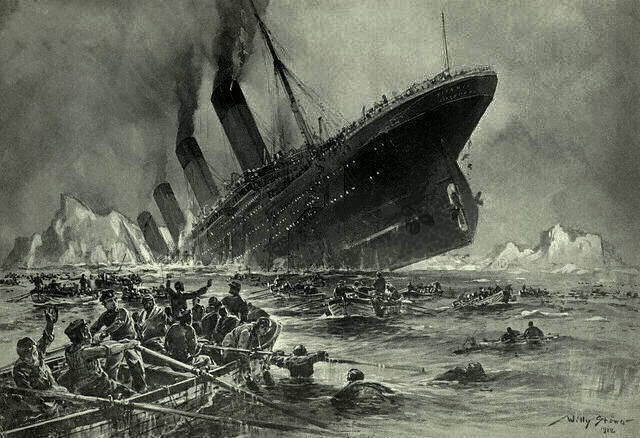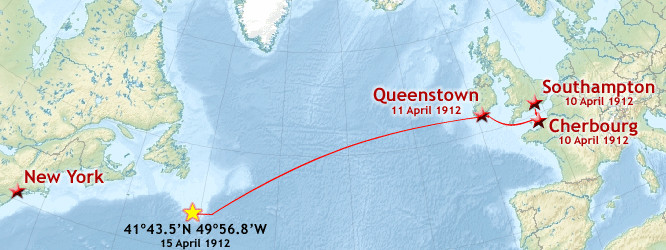Titanic sinks
04/15/1912 AD destroyed
At 11:40 pm (ship's time) on 14 April, lookout Frederick Fleet spotted an iceberg immediately ahead of Titanic and alerted the bridge. First Officer William Murdoch ordered the ship to be steered around the obstacle and the engines to be reversed, but it was too late; the starboard side of Titanic struck the iceberg, creating a series of holes below the waterline.
The hull was not punctured by the iceberg, but rather dented such that the hull's seams buckled and separated, allowing water to rush in. Five of the ship's watertight compartments were breached. It soon became clear that the ship was doomed, as she could not survive more than four compartments being flooded. Titanic began sinking bow-first, with water spilling from compartment to compartment as her angle in the water became steeper.
Those aboard Titanic were ill-prepared for such an emergency. In accordance with accepted practices of the time, as ships were seen as largely unsinkable and lifeboats were intended to transfer passengers to nearby rescue vessels, Titanic only had enough lifeboats to carry about half of those on board; if the ship had carried her full complement of about 3,339 passengers and crew, only about a third could have been accommodated in the lifeboats. The crew had not been trained adequately in carrying out an evacuation. The officers did not know how many they could safely put aboard the lifeboats and launched many of them barely half-full.
Third-class passengers were largely left to fend for themselves, causing many of them to become trapped below decks as the ship filled with water. The "women and children first" protocol was generally followed when loading the lifeboats,] and most of the male passengers and crew were left aboard. In 2022, Claes-Gõran Wetterholm, an author and expert on the Titanic, argued it was "not true" that women and children survived thanks to the gallantry of men; of the last survivors escaping on the final lifeboats leaving the starboard side of the ship, he said, the majority were men.
Between 2:10 and 2:15 am, a little over two and a half hours after Titanic struck the iceberg, her rate of sinking suddenly increased as the boat deck dipped underwater, and the sea poured in through open hatches and grates. As her unsupported stern rose out of the water, exposing the propellers, the ship broke in two main pieces between the second and third funnels, due to the immense forces on the keel. With the bow underwater, and air trapped in the stern, the stern remained afloat and buoyant for a few minutes longer, rising to a nearly vertical angle with hundreds of people still clinging to it, before foundering at 2:20 am.
It was long generally believed the ship sank in one piece; but the discovery of the wreck many years later revealed that the ship had broken fully in two. All remaining passengers and crew were immersed in lethally cold water with a temperature of −2 °C (28 °F). Sudden immersion into freezing water typically causes death within minutes, either from cardiac arrest, uncontrollable breathing of water, or cold incapacitation (not, as commonly believed, from hypothermia),[n] and almost all of those in the water died of cardiac arrest or other bodily reactions to freezing water, within 15–30 minutes. Only five of them were helped into the lifeboats, though the lifeboats had room for almost 500 more people.
Lattitude: 41.7255° N
Longitude: 49.9469° W
Region: North America

Modern Day Canada
Subjects Who or What destroyed?
-
RMS Titanic British passenger liner,...
Attachments
The route of Titanic's maiden voyage Titanic was planned to arrive at New York Pier 59 on the morning of 17 April. After leaving Queenstown, Titanic followed the Irish coast as far as Fastnet Rock, a distance of some 55 nautical miles. From there she travelled 1,620 nautical miles along a Great Circle route across the North Atlantic to reach a spot in the ocean known as "the corner" south-east of Newfoundland, where westbound steamers carried out a change of course. Titanic sailed only a few hours past the corner on a rhumb line leg of 1,023 nautical miles to Nantucket Shoals Light when she made her fatal contact with an iceberg. The final leg of the journey would have been 193 nautical miles to Ambrose Light and finally to New York Harbor.
Events in 1912 MORE











